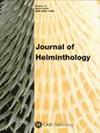药用植物 Cardiospermum halicacabum 的提取物对 Brugia pahangi 的体外抗丝虫活性
IF 1.3
3区 生物学
Q4 PARASITOLOGY
引用次数: 0
摘要
研究了药用植物红心草(Cardiospermum halicacabum)的乙醇提取物和水提取物对巴氏杆菌成虫和微丝蚴的体外影响。在培养基中添加或不添加植物提取物的情况下,每天监测成虫、微丝蚴和雌虫微丝蚴的释放情况。培养 7 天后,使用 MTT 试验评估成虫的活力或组织损伤。当浓度为 500 μg ml-1 时,接触 24 小时后,水提取物可显著降低雌性成虫的运动能力,3 天后可显著降低雄性成虫的运动能力。500 μg ml-1 的水提取物还能从第 2 天开始显著减少雌虫的微丝蚴释放。成虫蠕动的减少和雌虫微丝蚴释放的模式与浓度和时间有关。MTT 试验结果显示,在 500 μg ml-1 水提取物存在下培养的成虫受到了损害。然而,水提取物并不影响微丝蚴的运动,但高浓度提取物中的微丝蚴除外。较高浓度的乙醇提取物(2 毫克毫升-1)可抑制成虫的蠕动和雌虫微丝蚴的释放。MTT 试验检测出乙醇提取物的影响很小,因为只接触最高浓度(2 毫克毫升-1)的乙醇提取物对蠕虫造成的损害很小。然而,500 μg ml-1 的乙醇提取物能在第 2 天迅速降低微丝蚴的运动能力。本研究揭示了卤虫茧蜂属植物的水提取物对 B. pahangi 有轻微但明确的直接杀大丝蚴作用。本文章由计算机程序翻译,如有差异,请以英文原文为准。
In vitro antifilarial activity of extracts of the medicinal plant Cardiospermum halicacabum against Brugia pahangi
The in vitro effects of ethanol and aqueous extracts of the medicinal plant Cardiospermum halicacabum on adult worms and microfilariae of Brugia pahangi were investigated. With or without the plant extracts in culture medium, the motility of adult worms, microfilariae and microfilarial release from female worms were monitored daily. After 7 days of culture, viability or tissue damage of adult worms was assessed using the MTT assay. At > 500 μg ml-1 , the aqueous extract significantly reduced motility of adult females after 24 h of exposure and adult males after 3 days. The aqueous extract, at > 500 μg ml-1 , also significantly reduced microfilarial release from female worms, starting on day 2. The reduction in the motility of adult worms and the pattern of microfilarial release from female worms were concentration and time dependent. The MTT assay results revealed that adult worms cultured in the presence of aqueous extracts at > 500 μg ml-1 were damaged. However, the aqueous extract did not affect the motility of microfilariae with the exception of those in higher concentration extracts. Higher concentrations of ethanol extracts (2 mg ml-1 ) inhibited both the motility of adult worms and the release of microfilariae from females. Little effect of ethanol extracts was detected by the MTT assay, as only slight damage was caused to worms exposed only to the highest concentration (2 mg ml-1 ). However, ethanol extract at 500 μg ml-1 rapidly reduced the motility of microfilariae on day 2. The present study revealed that an aqueous extract of C. halicacabum has mild but definite direct macrofilaricidal action on B. pahangi .
求助全文
通过发布文献求助,成功后即可免费获取论文全文。
去求助
来源期刊

Journal of Helminthology
生物-动物学
CiteScore
2.80
自引率
12.50%
发文量
127
审稿时长
3 months
期刊介绍:
Journal of Helminthology publishes original papers and review articles on all aspects of pure and applied helminthology, particularly those helminth parasites of environmental health, medical or veterinary importance. Research papers on helminths in wildlife hosts, including plant and insect parasites, are also published along with taxonomic papers contributing to the systematics of a group. The journal will be of interest to academics and researchers involved in the fields of human and veterinary parasitology, public health, microbiology, ecology and biochemistry.
 求助内容:
求助内容: 应助结果提醒方式:
应助结果提醒方式:


